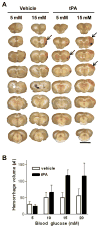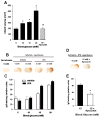Hyperglycemia promotes tissue plasminogen activator-induced hemorrhage by Increasing superoxide production
- PMID: 22002675
- PMCID: PMC4554391
- DOI: 10.1002/ana.22538
Hyperglycemia promotes tissue plasminogen activator-induced hemorrhage by Increasing superoxide production
Abstract
Objective: Risk of intracerebral hemorrhage is the primary factor limiting use of tissue plasminogen activator (tPA) for stroke. Clinical studies have established an association between admission hyperglycemia and the risk of hemorrhage with tPA use, independent of prior diabetes. Here we used an animal model of tPA-induced reperfusion hemorrhage to determine if this clinical association reflects a true causal relationship.
Methods: Rats underwent 90 minutes of focal ischemia, and tPA infusion was begun 10 minutes prior to vessel reperfusion. Glucose was administered during ischemia to generate blood levels ranging from 5.9 ± 1.8mM (normoglycemia) to 21 ± 2.3mM. In some studies, apocynin was administered to block superoxide production by nicotinamide adenine dinucleotide phosphate (NADPH). Brains were harvested 1 hour or 3 days after reperfusion to evaluate the effects of hyperglycemia and apocynin on oxidative stress, blood-brain barrier breakdown, infarct volume, and hemorrhage volume.
Results: Rats that were hyperglycemic during tPA infusion had diffusely increased blood-brain barrier permeability in the postischemic territory, and a 3- to 5-fold increase in intracerebral hemorrhage volumes. The hyperglycemic rats also showed increased superoxide formation in the brain parenchyma and vasculature during reperfusion. The effects of hyperglycemia on superoxide production, blood-brain barrier disruption, infarct size, and hemorrhage were all attenuated by apocynin.
Interpretation: These findings demonstrate a causal relationship between hyperglycemia and hemorrhage in an animal model of tPA stroke treatment, and suggest that this effect of hyperglycemia is mediated through an increase in superoxide production by NADPH oxidase.
Copyright © 2011 American Neurological Association.
Conflict of interest statement
Figures





References
-
- NINDS rt-PA Study Group. Tissue plasminogen activator for acute ischemic stroke. The National Institute of Neurological Disorders and Stroke rt-PA Stroke Study Group. N Engl J Med. 1995;333:1581–1587. - PubMed
-
- Demchuk AM, Morgenstern LB, Krieger DW, et al. Serum glucose level and diabetes predict tissue plasminogen activator-related intracerebral hemorrhage in acute ischemic stroke. Stroke. 1999;30:34–39. - PubMed
-
- Bruno A, Levine SR, Frankel MR, et al. Admission glucose level and clinical outcomes in the NINDS rt-PA Stroke Trial. Neurology. 2002;59:669–674. - PubMed
-
- Alvarez-Sabin J, Molina CA, Montaner J, et al. Effects of admission hyperglycemia on stroke outcome in reperfused tissue plasminogen activator--treated patients. Stroke. 2003;34:1235–1241. - PubMed
-
- Kase CS, Furlan AJ, Wechsler LR, et al. Cerebral hemorrhage after intra-arterial thrombolysis for ischemic stroke: the PROACT II trial. Neurology. 2001;57:1603–1610. - PubMed
Publication types
MeSH terms
Substances
Grants and funding
LinkOut - more resources
Full Text Sources
Medical

